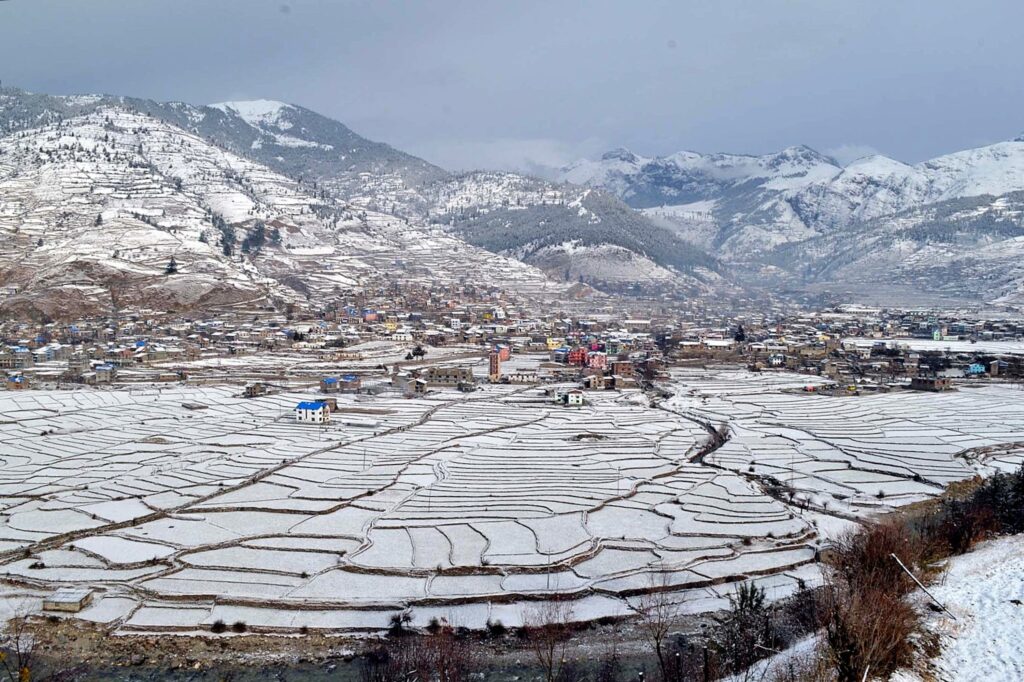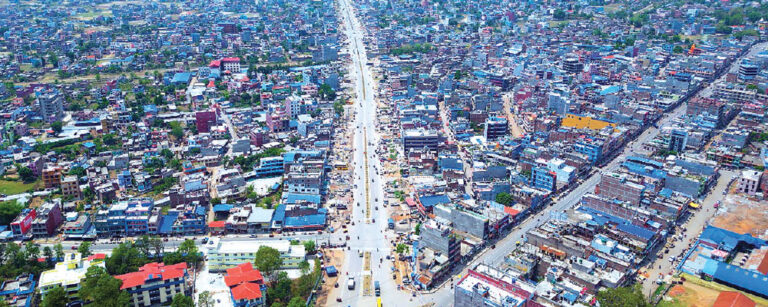A Voyage to Nepal’s Highland Sanctuary
Wedged into the heart of the Himalayas, Jumla District is a tapestry woven with verdant valleys, snow-capped peaks, and a cultural palette so vibrant it dazzles the soul. As the dawn light kisses the apex of the mountains, one cannot help but feel the ancient heartbeat of Nepal in this remote highland sanctuary. This is a tale of my journey into the essence of Jumla, a district that beckons the intrepid traveler with promises of adventure and enlightenment.
Geographical Canvas and Climate Brushstrokes of Jumla
The Jumla District is like a canvas where Mother Nature has painted her masterpiece. Cradled in the mid-western part of Nepal, Jumla shares borders with the equally picturesque districts of Dolpa, Kalikot, Mugu, and Humla. Each of these neighbors contributes to the region’s famed topographical variety, making it a grand stage where nature unfolds its dramatic plays. The terrain in Jumla is a symphony of soaring altitudes, plunging river valleys, and expansive terraces carved by the diligent hands of both man and time.

With elevations that dramatically range from 2,000 to 4,000 meters above sea level, Jumla is a land of geographical wonders. Here, you’ll find the precipitous slopes that challenge even the most experienced trekkers and rolling hills that soothe the soul with their greenery. It’s not just the elevation that’s varied, though; the district’s diverse landscape is punctuated by rivers like the Tila and the Sinja, which have played pivotal roles in both the ecosystem’s sustenance and the area’s historical narratives.
The climate of Jumla is a tale of two stories. In the summer, the air is warm and heavy with the scent of blooming rhododendrons. These months transform the district into a green sanctuary, a perfect cradle for the famous Jumla apples to ripen to their renowned sweetness. Come winter, and the scene shifts dramatically. The air becomes a crisp whisper, carrying with it the promise of snow that soon blankets the earth in a pristine layer of white. It’s a time when the cold not only bites but also sings the songs of the highlands—a testament to the resilience of the communities that call this place home.

Visitors to Jumla will quickly discover that its climate is not just about the weather; it’s a central character in the story of the region. It shapes daily life, influences local agriculture, and even dictates the unique patterns of human settlement throughout the district. The result is a place where nature and culture are intertwined, each element influencing the other to create the beautiful tapestry that is Jumla’s identity.
A Mosaic of Culture and Language in Jumla
The cultural landscape of Jumla District is as intricate and colorful as the patterns on a traditional Nepali rug. Here, the past and present merge in the spoken word and the lived experiences of its inhabitants. The Khas language, an emblem of the district’s rich history, resonates through the valleys, telling tales of the ancient ‘Khasa’ kingdom. This language is not just a means of communication; it is a living museum of the district’s past, a vital link that connects the new generations with their forebears.

In the everyday life of Jumla, one can witness a harmonious symphony of diverse ethnic groups, each contributing a unique note to the collective melody of the region. The Chhetris, with their warrior ancestry and agrarian lifestyle, bring strength and endurance. The Thakuris, known for their leadership in the annals of history, contribute a sense of pride and tradition. Meanwhile, the influence of Tibetan culture is seen in the prayer flags that dance in the high-altitude wind, a testament to the spirituality and resilience of the people.
The cultural fabric of Jumla is stitched together with threads of various traditions and customs. The festivals celebrated, the clothes worn, the food eaten, and the music played are all vibrant expressions of a rich and enduring heritage. Each ethnic group, while preserving its unique customs and practices, also participates in the shared cultural narrative of the district.
Amidst this cultural diversity, the quest for knowledge is a unifying force. The literacy rate in Jumla is a testament to the community’s commitment to education and progress. Schools serve as beacons of hope, illuminating young minds and empowering them to weave their own stories into the district’s grand tapestry. The region’s literacy efforts reflect an understanding that education is the key to unlocking the potential of its youth and securing a prosperous future.

The spiritual life in Jumla is as varied as its cultural expressions. From the indigenous animist practices to Hindu temples and Buddhist monasteries, the district is a confluence of faiths. Each religious practice is performed with a deep reverence for the divine and a respect for the different paths that lead to it. The coexistence of various religions in Jumla is not just peaceful; it is celebratory, each community finding joy in the other’s spiritual celebrations and rites.
Ultimately, Jumla’s culture and language are not static; they are dynamic and evolving. They are kept alive in the stories passed down through generations, in the laughter of children learning their ancestors’ tongue, and in the everyday acts of kindness that define the spirit of this Himalayan enclave. It is a place where every stone, stream, and summit has a story, waiting to be told.
Chandannath: The Heartbeat of Jumla
Chandannath stands as the pulsing heart of the Jumla District, a place steeped in spiritual and historical significance. Here, in the town of Khalanga, the headquarters of the district, the ancient and the everyday converge. The town gets its name from the revered Chandannath Temple, which is not just a religious landmark but also a cornerstone of the community’s cultural heritage. The temple’s annual fair is a time of vibrant celebration, attracting visitors from across the region who come to pay homage and partake in the festive atmosphere.

In Chandannath, life unwinds at a pace that is in harmony with the natural rhythm of the seasons. The local bazaar is the lifeline of the area, buzzing with the energy of trade and the warm banter of its people. This market is a treasure trove for those who seek the authentic Jumla experience. It is a place where the region’s famed apples are more than just produced; they are the golden bulbs of local pride and a crucial component of the economy.
Local Governance: A Reflection of Democracy in Jumla
The administrative machinery of Jumla is intricate and robust, designed to reflect the ethos of local governance and democracy. The district is divided into eight local government units, each with a unique identity and role within the larger district framework. Chandannath Municipality, serving as the administrative center, is a microcosm of Jumla’s diversity and dynamism. Surrounding it are the rural municipalities—Hima, Tila, Patrasi, Kanakasundari, Guthichaur, Tatopani, and Kali Kumaon. These units are the backbone of local administration, ensuring that democracy functions from the ground up.

The local governments are tasked with a myriad of responsibilities, from maintaining infrastructure to overseeing educational initiatives. Each municipality has its own assembly, reflecting the voices and votes of the local populace. This decentralized approach to governance ensures that decision-making is sensitive to the unique needs and aspirations of each area within Jumla.
These local government bodies are also custodians of Jumla’s cultural and natural assets. They work to preserve the district’s rich traditions, protect its environment, and promote sustainable development. By fostering local talent and resources, they aim to write a narrative of self-sufficiency and resilience for Jumla.
In essence, the local governments of Jumla are more than just administrative entities; they are the threads that weave the social fabric of the district, ensuring that the tapestry of Jumla’s culture remains vibrant and intact for future generations.

Trailblazing to Jumla’s Jewels
The landscape of Jumla is a veritable trove of natural and historical gems, each beckoning the intrepid traveler with the promise of unparalleled beauty and a brush with the annals of time. The district is home to attractions that offer not just visual delight but also profound insights into the natural and cultural ethos of this Himalayan paradise.
- Rara Lake: Often referred to as the ‘Queen of Lakes,’ Rara Lake is a shimmering blue wonder, the largest lake in Nepal, cradled by the verdant hills of the Rara National Park. This alpine freshwater lake is situated at an altitude of over 2,990 meters and offers a tranquil escape from the world. A trek to Rara is an immersion into serenity, where the only sounds are the lapping of the crystal-clear waters against the shore and the melodic symphony of the resident birds. Surrounded by pine, spruce, and juniper forests, it is a biodiversity hotspot that thrives in seclusion, offering solace and stunning scenery to those who venture here.
- Sinja Valley: The Sinja Valley is a testament to the historical grandeur of Jumla and the origins of the Nepali language. It was here that the early scripts, dating back to the 13th century, were discovered, etching Sinja’s name into the annals of linguistic history. As the erstwhile capital of the powerful Khasa kingdom, the valley is littered with archaeological relics that narrate stories of a bygone era. Today, the valley’s terraced fields, traditional villages, and the remnants of ancient temples are eloquent expressions of Nepal’s enduring legacy.
- Danphe Lagna Pass: A route less traversed but teeming with the raw beauty of Jumla is the trail through Danphe Lagna Pass. Situated at an elevation of around 3,500 meters, this pass offers panoramas that can humble the most seasoned traveler. It is named after the national bird of Nepal, the Danphe or the Impeyan pheasant, known for its magnificent plumage. Trekking through this pass is an adventure in itself, with each turn presenting a new vista, a fresh perspective of the mighty Himalayas. For those willing to take the road less traveled, Danphe Lagna Pass rewards with vistas that are the stuff of dreams—a hiker’s and a photographer’s delight.

These are but a few of the jewels in Jumla’s crown, with each attraction offering a unique experience to the visitor. Whether it’s the peaceful lap of lake waters, the whispers of ancient ruins, or the thrill of conquering mountain passes, Jumla invites you to write your own adventure amidst its wonders.
Frequently Asked Questions
Embark on a journey to Rara Lake, the historic Sinja Valley, and take a trek through Danphe Lagna Pass for a truly immersive experience.
Jumla dances to the rhythm of its alpine climate, where summers bloom with verdure and winters wrap the land in a pristine white embrace.
The district is a cradle of diversity, with Chhetris, Thakuris, and influences from Tibetan culture, each contributing to its vibrant social fabric.
Education in Jumla is on an upward trajectory, with literacy rates climbing as schools become more accessible across the district.
Khas is the lingua franca here, but the air is also filled with the sounds of Nepali, along with the dialects of various indigenous groups.
In closing, the pulse of Jumla District is felt through its rugged paths, its whispering woods, and its people—a rhythm that resonates with the heart of Nepal. Here, the traveler does not simply visit; they become a part of a story that continues to unfold with each sunrise over the Himalayas. To step into Jumla is to step into a world that transcends the boundaries of time, a world that, once visited, becomes a part of you forever.

If you know any more places where we can visit or any other information then feel free to comment or message us.
You can find article in Nepali language here.
Watch videos of different places on YouTube channel named as THE SANDESH NEUPANE or click here.
All the photo copyright to the respective owner. For any querry or anything related to copyright mail me with proof at sandesh@thesandeshneupane.com or admin@thesandeshneupane.com .







